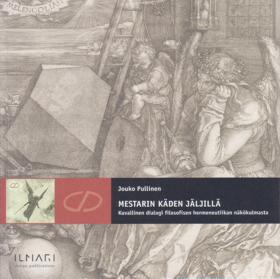Author: Jouko Pullinen
Institution: University of Art and Design Helsinki UIAH
Doctoral dissertation / Title: Following a Master – Visual Dialogue Seen from a Hermeneutical Perspective
My doctoral thesis is a philosophical account of a journey to investigate the crucial questions an art educator must address: in which way and under which conditions does new understanding come about in visual expression and interpretation?
My aim in this study was to explore the artistic dialogue process and how it can be perceived as a hermeneutical interpretation. The study is divided into two parts:
- The art work, which consisted of a dialogue between me as an artist as a researcher and two of Albrecht Dürer’s works of art, Adam and Eve andMelancholy. The dialogue lead to art exhibitions which were displayed in Galleria G in 1997, and in 1999 in the Hämeenlinna Art Museum and in the Sinebrychoff Art Museum.
- The theoretical part is an investigation I conducted into the visual dialogue process employed. My frame of reference is philosophical, in particular Gadamerian hermeneutics.
I approach the making of a work of art as a method of study. My starting point is that a visual artist can find a parallel in, say, a hermeneutician working as an anthropologist.
The dissertation consists of two main parts. Firstly, I discuss the explorative nature of visual arts from the following view points: (1) What is an artist researcher’s relationship to the surrounding reality and to the object of his/her study? This question is expanded to encompass researchers’ position in, and relationship to, the world at large: are researchers like a fly on the wall, on-lookers, or by-standers, or are they more actively involved, with all their senses, taking in the world? (2) What is artist researchers’ relationship with their own art work? Here, I examine the method of study. What has ‘skill’ to do with anything, and how is silent knowledge conveyed in the works of art created?
(3) What is the relation of a work of art to reality? I approach this relation from the perspective of semiotics, which provides points of view for the discussion of an art work and its meanings.
In the second part I discuss hermeneutics, and in particular Hans-Georg Gadamer’s views of hermeneutical interpretation, in order to propose a research method for the visual arts. Gadamer’s main ideas on the dialogic structure of understanding a text are (1) identification of preunderstandings; (2) the interactive process of the dialogue which leads to a fusion of horizons; and (3) the application of the interpreted. These phases of understanding are relevant to an artist researcher. An understanding cannot emerge from ‘out there’ but is always based on the encounter of the already known with the present, subject to our preunderstandings. The preunderstanding will evolve in the dialogue with the object of interpretation, and in the fusion of horizons we gain new understanding. When the horizons of those involved in the dialogue intersect or engage, a third horizon, broader than the first two, comes into existence. In ‘application’ an emphasis is given to the interpreter’s horizon or tradition, on the one hand, and on the application of the interpreted in the interpreter’s life. A Gadamerian interpretation brings about a change in the interpreter by enriching his/her horizon.
My dissertation incorporates a lot of visual material which aims to throw light on the dialogue process and to document my art exhibitions, which form an integral part of the study. The work is comprised of both academic and belletristic texts. I wish to invite the reader to join in a dialogue with the visual and with these texts, in a dialogue aimed at providing the reader with new understanding of research in the visual arts.

